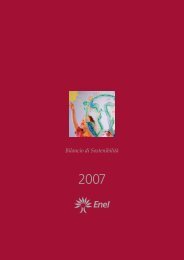Annual Report 2010 - Enel.com
Annual Report 2010 - Enel.com
Annual Report 2010 - Enel.com
Create successful ePaper yourself
Turn your PDF publications into a flip-book with our unique Google optimized e-Paper software.
Expected cash flows from interest rate derivatives<br />
Millions of euro Fair value Stratification of expected cash flows<br />
at Dec. 31,<br />
<strong>2010</strong> 2011 2012 2013 2014 2015 Beyond<br />
CFH on interest rates<br />
Positive fair value 8 (2) (2) - 5 1 4<br />
Negative fair value<br />
FVH on interest rates<br />
(569) (267) (186) (99) (51) (21) (50)<br />
Positive fair value 9 3 2 2 1 1 4<br />
Negative fair value<br />
Trading derivatives on interest rates<br />
- - - - - - -<br />
Positive fair value 8 3 3 2 1 1 -<br />
Negative fair value (190) (102) (61) (19) (9) (3) (30)<br />
The amount of floating-rate debt that is not hedged<br />
against interest rate risk is the main risk factor that could<br />
impact the in<strong>com</strong>e statement (raising borrowing costs) in<br />
the event of an increase in market interest rates.<br />
At December 31, <strong>2010</strong>, 39% of net long-term financial<br />
debt was floating rate (51% at December 31, 2009). Taking<br />
into account cash flow hedges of interest rates considered<br />
effective pursuant to the IFRS-EU, 14% of the debt<br />
was exposed to interest rate risk at December 31, <strong>2010</strong><br />
(26% at December 31, 2009). Including interest rate derivatives<br />
treated as hedges for management purposes but<br />
ineligible for hedge accounting, the residual exposure<br />
would be 7% (20% at December 31, 2009).<br />
If interest rates had been 1 basis point higher at December<br />
31, <strong>2010</strong>, all other variables being equal, shareholders’ equity<br />
would have been about €3 million higher (€5 million<br />
at December 31, 2009) as a result of the increase in the fair<br />
value of CFH derivatives on interest rates. Conversely, if interest<br />
rates had been 1 basis point lower at that date, all<br />
other variables being equal, shareholders’ equity would<br />
have been €3 million lower (€5 million at December 31,<br />
2009) as a result of the decrease in the fair value of CFH<br />
derivatives on interest rates.<br />
An equivalent increase (decrease) in interest rates, all other<br />
variables being equal, would have a negative (positive)<br />
impact on the in<strong>com</strong>e statement in terms of higher (lower)<br />
interest expense on the portion of debt not hedged<br />
against interest rate risk of about €301 thousand (€1 million<br />
at December 31, 2009).<br />
Exchange rate risk<br />
Exchange rate risk is mainly generated with the following<br />
transaction categories:<br />
174 <strong>Enel</strong> <strong>Annual</strong> <strong>Report</strong> <strong>2010</strong> Consolidated financial statements<br />
> debt denominated in currencies other than the functional<br />
currency of the respective countries entered into<br />
by the holding <strong>com</strong>pany or the individual subsidiaries;<br />
> cash flows in respect of the purchase or sale of fuel or<br />
electricity on international markets;<br />
> cash flows in respect of investments in foreign currency,<br />
dividends from unconsolidated foreign <strong>com</strong>panies<br />
or the purchase or sale of equity investments.<br />
In order to minimize this risk, the Group normally uses a<br />
variety of over-the-counter (OTC) derivatives such as currency<br />
forwards, cross currency interest rate swaps and currency<br />
options. The term of such contracts does not exceed<br />
the maturity of the underlying financial liability, so that<br />
any change in the fair value and/or cash flows of such contracts<br />
is offset by a corresponding change in the fair value<br />
and/or cash flows of the underlying position.<br />
Cross currency interest rate swaps are used to transform<br />
a long-term fixed- or floating-rate liability in foreign currency<br />
into an equivalent fixed- or floating-rate liability in<br />
euros. In addition to having notionals denominated in different<br />
currencies, these instruments differ from interest<br />
rate swaps in that they provide both for the periodic exchange<br />
of cash flows and the final exchange of principal.<br />
Currency forwards are contracts in which the counterparties<br />
agree to exchange principal amounts denominated<br />
in different currencies at a specified future date and exchange<br />
rate (the strike). Such contracts may call for the actual<br />
exchange of the two amounts (deliverable forwards)<br />
or payment of the difference between the strike exchange<br />
rate and the prevailing exchange rate at maturity (non-deliverable<br />
forwards). In the latter case, the strike rate and/<br />
or the spot rate may be determined as averages of the official<br />
fixings of the European Central Bank.<br />
Currency options involve the purchase (or sale) of the









